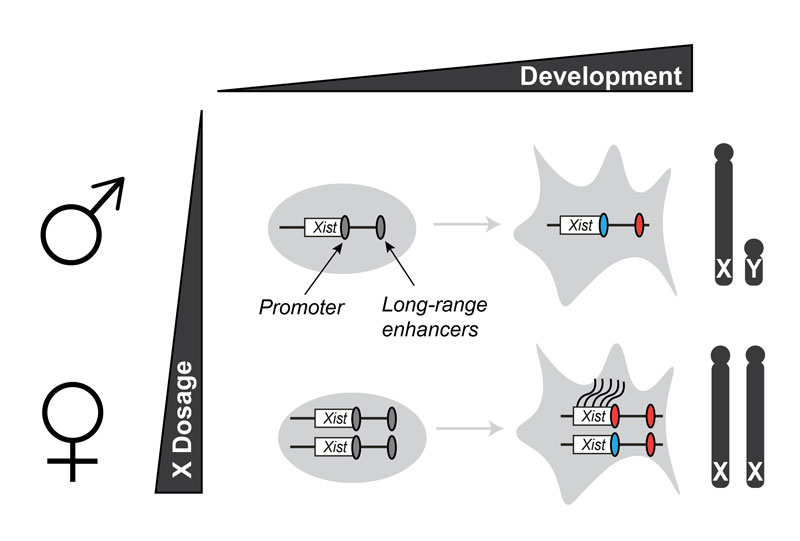Mammalian genes often respond to multiple signals at the same time to integrate detailed information on their environment and their internal state. An example is the Xist gene, which governs the process of X-chromosome inactivation and integrates information on developmental stage and sex of the embryo. Developmental cues and X-chromosomal dosage together ensure that Xist will be upregulated from only one X chromosome in female embryos at a specific embryonic stage to induce inactivation of that chromosome, thereby ensuring dosage compensation for X-chromosomal genes.

Figure: The Xist gene is activated on one X chromosome in females during embryonic development. Long-range enhancers, which respond to developmental cues, and the promoter region, which is controlled by X-chromosomal dosage, have to be activated to allow Xist upregulation. Elements colored in red are active, those in blue repressed and those shown in grey are in a neutral state.
Supported by an HFSP Career Development Award, Edda Schulz and her team discovered a previously unknown genomic region that allows the Xist gene to sense the developmental state of the cell. This region, located 150 kb away from the Xist promoter, contains a series of long-range enhancer elements and also produces a previously unannotated long non-coding RNA, which was named Xert for Xist-enhancing regulatory transcript. The Xert region becomes active when X inactivation is initiated, and is brought into close physical proximity of the Xist promoter, thereby determining the timing of Xist upregulation.
Activation of the Xert region is however not sufficient to activate the Xist gene. A second signal, which contains information on the sex of the embryo, is required to keep the Xist promoter in a state that can respond to Xert activation. This signal is likely mediated by increased X-chromosomal dosage in females and keeps the Xist promoter in an activatable state. In male cells this signal is too weak, such that the promoter is switched off, making it insensitive to long-range activation by Xert.
In summary, the signals that inform the Xist gene on developmental stage and sex, respectively, are sensed by distinct genomic regions. Each region acts as a genetic switch that can be turned by the respective signal. The promoter-proximal switch, which integrates information on X-dosage, is dominant and can therefore prevent Xist expression in male embryos. The other switch, which controls Xist from a distance and responds to developmental cues, will boost gene activity as long as the promoter is in a permissive state. Such a distal-proximal hierarchy might be a general principle that allows coincidence detection of two different signals. This study is thus a first step towards understanding how the wiring of complex genetic circuits is implemented at the molecular level.
|
HFSP award information Career Development Award (CDA00064/2018-C): Towards a quantitative understanding of the mechanistic coupling of X-inactivation and pluripotency Awardee: Edda Schulz |


































